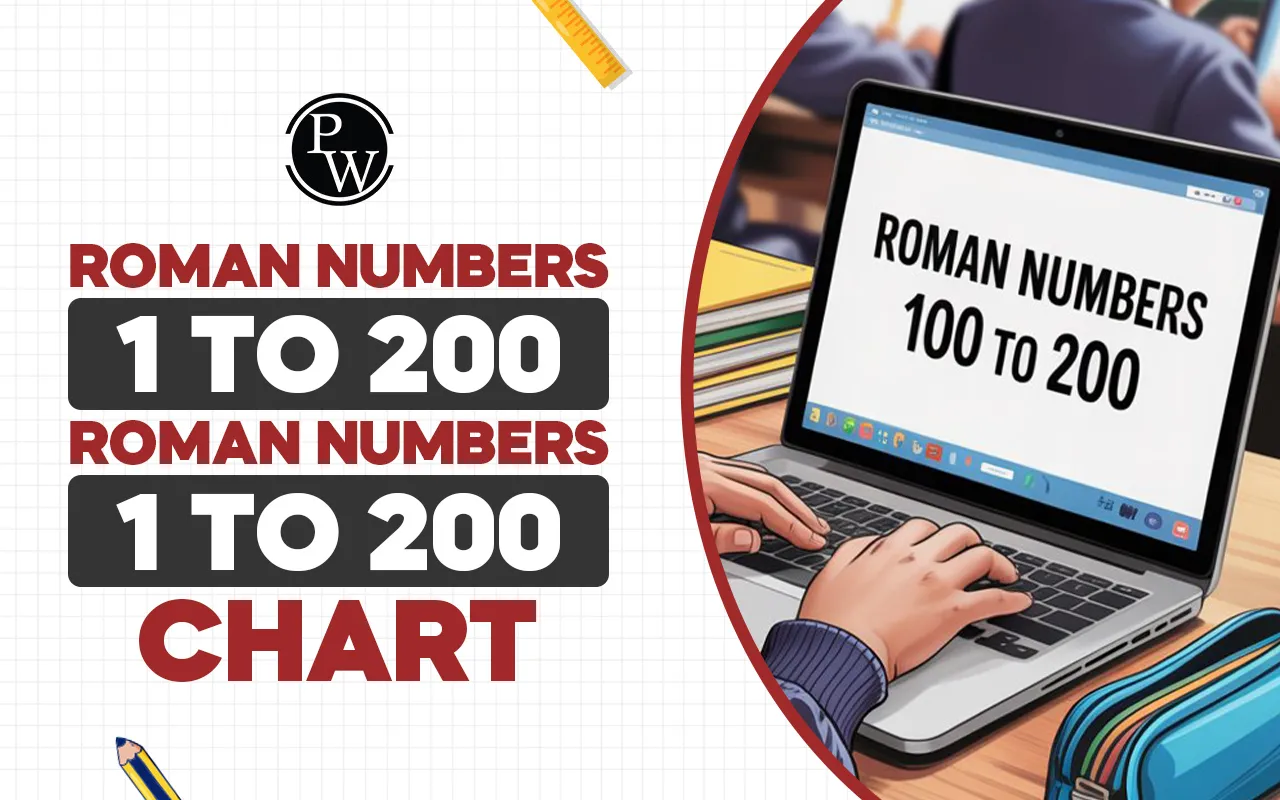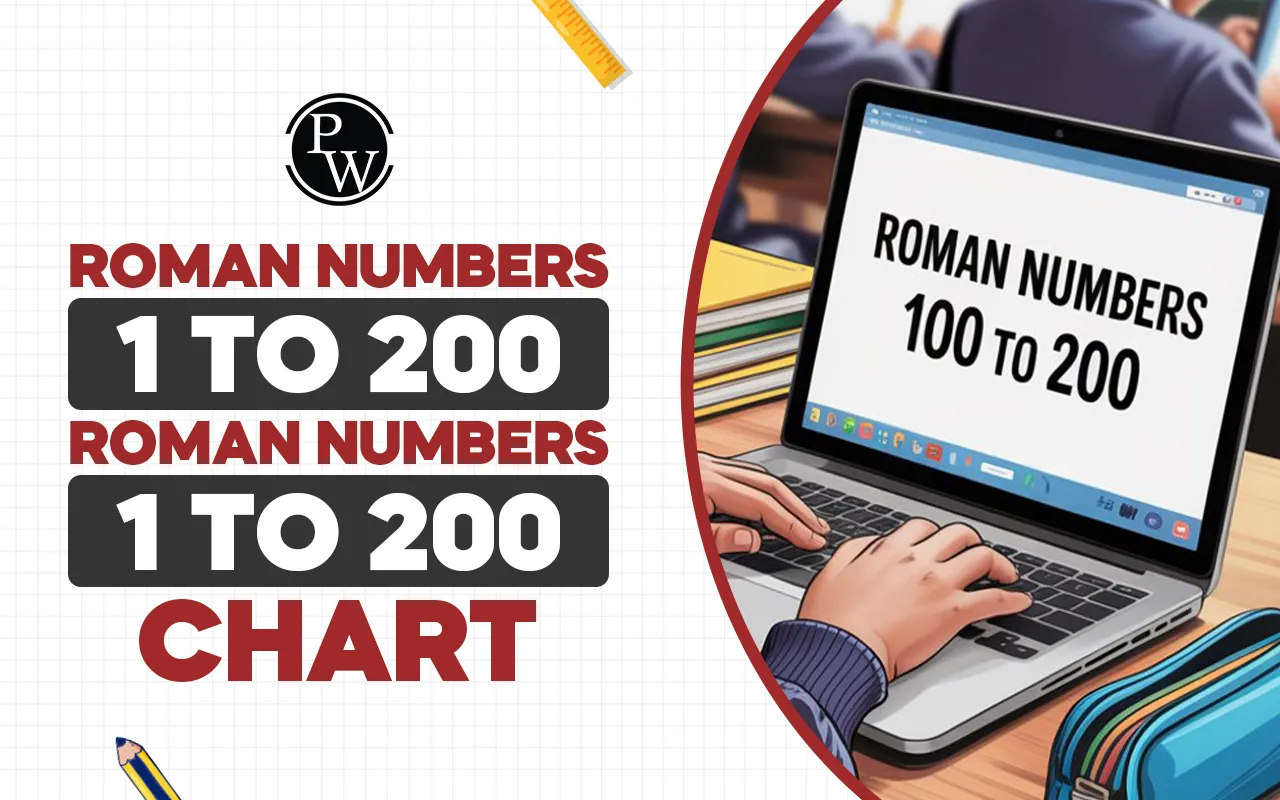

Roman Numbers 100 to 200
Roman numerals from 100 to 200 are part of the classical number system used in ancient Rome and still visible in modern times. This range plays an important role in expanding a learner’s understanding of Roman counting beyond the basics. After mastering numbers from I (1) to X (10) and up to XC (90), learners begin working with more complex Roman numbers, such as C (100) and beyond.
The Roman numerals 100 to 200 are formed using specific symbols like C, L, X, V, and I. These symbols are arranged according to certain rules. Students can check the Roman numbers 100 to 200 chart, learn how to write them, explore the rules, review some examples, and more below.
Read More: Roman Numerals 1 to 100
Roman Numbers 100 to 200 Chart
The Roman numbers 100 to 200 chart is a helpful tool that shows how each number from 100 to 200 is written using Roman numeral symbols. It provides a clear reference to recognize patterns and understand how numbers are built.
|
Roman Numbers 100 to 200 Chart |
|||||
|
Number |
Roman Numeral |
Number |
Roman Numeral |
Number |
Roman Numeral |
|
100 |
C |
125 |
CXXV |
150 |
CL |
|
101 |
CI |
126 |
CXXVI |
151 |
CLI |
|
102 |
CII |
127 |
CXXVII |
152 |
CLII |
|
103 |
CIII |
128 |
CXXVIII |
153 |
CLIII |
|
104 |
CIV |
129 |
CXXIX |
154 |
CLIV |
|
105 |
CV |
130 |
CXXX |
155 |
CLV |
|
110 |
CX |
140 |
CXL |
160 |
CLX |
|
120 |
CXX |
145 |
CXLV |
170 |
CLXX |
|
180 |
CLXXX |
190 |
CXC |
200 |
CC |
This Roman numerals 100 to 200 chart helps students, teachers, and even history or literature fans quickly convert numbers and understand how Roman numerals scale from 100 to 200.
How to Write Roman Numbers 100 to 200?
To write 100 to 200 Roman numbers, we use a set of Latin letters that each have a specific value. These values combine to form other numbers in the system.
Basic Symbols:
-
C = 100
-
L = 50
-
X = 10
-
V = 5
-
I = 1
Step-by-Step Instructions:
-
Start with C (100): All numbers between 100 and 199 begin with the symbol C.
-
Add symbols for the remaining value: For example:
-
105 is C + V = CV
-
115 is C + X + V = CXV
-
161 is C + L + X + I = CLXI
-
For 200, use two Cs: Since 100 is C, 200 is CC.
Using these steps helps learners write and recognize Roman numerals from 100 to 200 with confidence.
Read More: XXV Roman Numerals
Rules to Write Roman Numbers 100 to 200
Writing Roman numerals 100 to 200 correctly depends on following a set of classical rules. These rules were designed to keep the number system clear and consistent.
1. Additive Rule
If a smaller or equal symbol comes after a larger one, you add their values.
Example:
-
C + X + V = CXV (100 + 10 + 5 = 115)
2. Subtractive Rule
If a smaller symbol is placed before a larger one, you subtract the smaller from the larger.
Examples:
-
C + IX = CIX (100 + 9 = 109)
-
C + XL = CXL (100 + 40 = 140)
3. No More Than Three Repeats
You should never repeat the same symbol more than three times in a row.
Correct:
-
XXX = 30
Incorrect:
-
XXXX is not allowed
4. Use Standard Combinations
Always use standard combinations instead of non-standard ones. For example, write 140 as CXL, not CXXXX.
5. Start with the Largest Value
Always begin with the highest numeral and then move to smaller values.
Example:
-
161 = C (100) + L (50) + X (10) + I (1) = CLXI
Following these rules ensures accurate and traditional Roman number writing from 100 to 200.
Read More: XXXVI Roman Numerals
Roman Numerals 100 to 200 Examples
Below are several Roman numerals 100 to 200 examples. These examples help demonstrate how to apply the rules in real numbers.
1. Simple Additive Examples:
These use direct addition of symbols.
-
100 = C
-
105 = CV
-
110 = CX
-
120 = CXX
-
130 = CXXX
2. Subtractive Notation Examples:
These show when a smaller number is placed before a larger one.
-
104 = CIV (5 - 1 = 4)
-
109 = CIX (10 - 1 = 9)
-
140 = CXL (50 - 10 = 40)
-
190 = CXC (100 - 10 = 90)
3. Mixed Examples:
These use both additive and subtractive principles.
-
115 = CXV (100 + 10 + 5)
-
167 = CLXVII (100 + 50 + 10 + 5 + 2)
-
199 = CXCIX (100 + 90 + 9)
These examples are especially helpful when practicing Roman numerals from 100 to 200 for schoolwork, historical reading, or daily use.
Also Read: Roman Numbers 1 to 10000
Help Your Child Become Faster and More Confident in Maths with CuriousJr
Does your child feel nervous while doing maths or get stuck during calculations? These small struggles can become bigger as school gets tougher. CuriousJr’s Online Mental Maths Classes help your child become faster and more confident in maths with:
-
Step-by-step lessons based on your child’s level.
-
Fun and easy topics that improve thinking and problem-solving.
-
50+ smart tricks to solve math problems quickly.
-
Visual methods and logic exercises for better understanding.
-
Games, rewards, and fun classes to keep kids interested.
-
Live video lessons with help for homework and doubts.
-
Daily progress reports so you can see how your child is improving.
-
Makes school maths easier and can help improve marks in exams.
Give your child the help they need to enjoy maths and do well.
